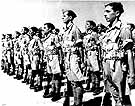
|
|
|

|

|

|

|
|
Click on an image to see a larger, more detailed picture.
|
|
|
|
|
| 1942: The "Final Solution" |

|
pg. 365 |

|
|
|
|
| |
 A child in a Ustasa children's camp in Sisak, Croatia. The Independent State of Croatia, led by the Ustasa movement, implemented a full complement of anti-Jewish legislation modeled on the Nuremberg Laws. The first concentration camp in Croatia was established early in 1941. In many camps men, women, and children were strictly segregated.
A child in a Ustasa children's camp in Sisak, Croatia. The Independent State of Croatia, led by the Ustasa movement, implemented a full complement of anti-Jewish legislation modeled on the Nuremberg Laws. The first concentration camp in Croatia was established early in 1941. In many camps men, women, and children were strictly segregated.
Photo: Lydia Chagoll / United States Holocaust Memorial Museum Photo Archive
|
 Arab resentment against the British role in the Middle East increased as more European Jews sought a homeland in Palestine, requiring British troops to keep peace between Jews and Arabs. Nonetheless, some Jews and Arabs were sympathetic to the British and joined the fight against the Nazis and Fascists. Arab leader Fakhri al-Nashashibi even urged his followers to join the British Army. Here, a squad of Arabs belonging to the Palestine Regiment is shown on parade after completing six months of training.
Arab resentment against the British role in the Middle East increased as more European Jews sought a homeland in Palestine, requiring British troops to keep peace between Jews and Arabs. Nonetheless, some Jews and Arabs were sympathetic to the British and joined the fight against the Nazis and Fascists. Arab leader Fakhri al-Nashashibi even urged his followers to join the British Army. Here, a squad of Arabs belonging to the Palestine Regiment is shown on parade after completing six months of training.
Photo: AP/Wide World
|
 Hajj Amin al-Husseini
Hajj Amin al-Husseini
The Muslim grand mufti of Jerusalem, Hajj Amin al-Husseini (pictured, left) was a nationalist Palestinian religious leader. In the 1930s he organized Arab attacks against the British and Jews in Palestine and Iraq. Fleeing British authorities, Husseini was greeted with open arms by the Nazis in Berlin. During World War II Husseini sympathized publicly and privately with the Nazis' antisemitism as well as with their anti-British policies. He spent most of the war in Berlin and reportedly visited several camps. Husseini obtained a promise from Hitler that after Germany conquered the Middle East, the Jews who resided there would suffer the same extermination as the European Jews. Husseini recruited thousands of European Muslims for service in the Waffen-SS. He escaped trial for war crimes, and after 1946 he spent the rest of his life entertained in various Middle Eastern capitals.
Photo: Central Zionist Archives / United States Holocaust Memorial Museum Photo Archive
|
|

|

|

|

|
 September 10-12, 1942: In Belgium, foreign Jews are seized in Antwerp. They are sent to a camp in Mechelen, Belgium, and then to forced labor in northern France.
September 10-12, 1942: In Belgium, foreign Jews are seized in Antwerp. They are sent to a camp in Mechelen, Belgium, and then to forced labor in northern France.
|
 September 11, 1942: Meir Berliner, an Argentine Jew deported to the Treblinka death camp from Warsaw, stabs an SS officer, Max Bialas, to death with a penknife. In reprisal, Berliner and 150 other Treblinka inmates are executed.
September 11, 1942: Meir Berliner, an Argentine Jew deported to the Treblinka death camp from Warsaw, stabs an SS officer, Max Bialas, to death with a penknife. In reprisal, Berliner and 150 other Treblinka inmates are executed.
|
 September 11, 1942: At Stolin, Belorussia, Jewish resistance is led by Moses Glazer and Asher Shapira.
September 11, 1942: At Stolin, Belorussia, Jewish resistance is led by Moses Glazer and Asher Shapira.
|
 September 11, 1942: Five thousand Jews are deported from the Warsaw Ghetto to Treblinka. Among the deportees is noted author Hillel Zeitlin, age 71.
September 11, 1942: Five thousand Jews are deported from the Warsaw Ghetto to Treblinka. Among the deportees is noted author Hillel Zeitlin, age 71.
|
|
|
|
|
| 1942: The "Final Solution" |

|
pg. 365 |

|
|
The Holocaust Chronicle
© 2009 Publications International, Ltd.
|
|
